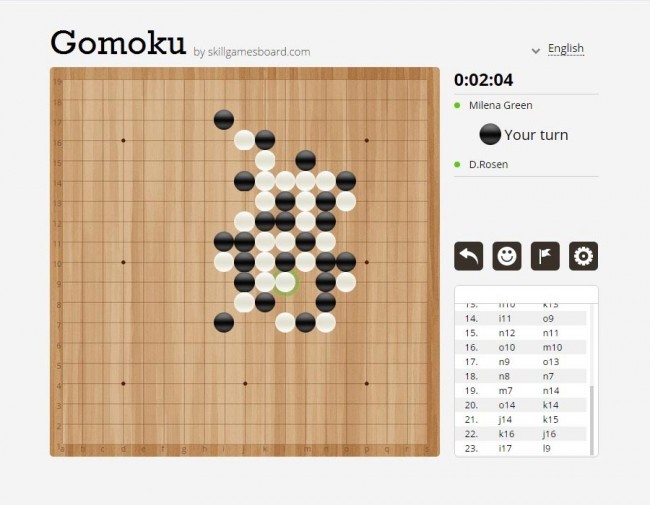Gomoku, a captivating strategy game that combines elements of wit and skill. If you’re eager to learn how to play Gomoku easily, you’ve come to the right place. In this guide, we’ll unravel the fundamentals of this classic board game, offering you a clear path to becoming a proficient Gomoku player. Whether you’re a beginner or looking to refine your skills, this piece will provide you with the knowledge and strategies to enjoy Gomoku with confidence and ease.
Table of contents
What Is Gomoku?
Gomoku, often referred to as “Five in a Row” or “Connect Five,” is a classic two-player board game that originated in East Asia. The objective of the game is to be the first to create a continuous unbroken line of five of your own pieces (usually represented by X or O) horizontally, vertically, or diagonally on the game board.
Gomoku is a game of strategy and pattern recognition, and it can be played on a variety of board sizes and with different rule variations, making it a popular and engaging pastime for players of all ages.
How To Play Gomoku
Playing Gomoku is relatively simple, and it can be enjoyed by players of all ages. Here are the basic rules to get you started:
- Game Setup: Gomoku is typically played on a 15×15 or 19×19 grid, but you can adapt the board size as per your preference. One player uses X and the other uses O as their game pieces.
- Objective: The goal is to be the first to form an unbroken line of five of your pieces, either horizontally, vertically, or diagonally.
- Taking Turns: Players take turns placing one of their pieces on an empty intersection of the grid. The first player (usually X) makes the opening move.
- Winning the Game: The game ends when one player successfully creates a line of five of their pieces. That player is declared the winner. If the entire board is filled without a winner, the game is considered a draw.
- Rules and Etiquette: Pieces should be placed at the intersections (cross points) on the grid, not inside the squares. Players should avoid creating lines that are longer than five, as it’s not a winning move but can be considered poor sportsmanship.
- Strategy: Gomoku is a game of strategy, and players need to think both defensively (blocking the opponent) and offensively (forming their own winning lines). Analyze patterns and anticipate your opponent’s moves.
- Variations: Depending on the region and house rules, some variations may exist. For example, some versions of Gomoku allow “overlines” (lines longer than five) to win, while others do not.
Rules For Gomoku
The rules for Gomoku (Five in a Row) are relatively straightforward, but they can vary slightly depending on regional or house rules. Here are the standard rules:
- Game Board: Gomoku is typically played on a 15×15 or 19×19 grid, but other sizes can be used as well.
- Players: Gomoku is a two-player game, where one player uses X and the other uses O as their game pieces.
- Objective: The primary goal is to be the first player to create an unbroken line of five of their pieces (either horizontally, vertically, or diagonally) on the game board.
- Taking Turns: Players take turns placing one of their pieces on an empty intersection (cross point) of the grid. The player using X usually goes first.
- Winning the Game: The game ends when one player successfully forms a line of five of their pieces. The player who achieves this is declared the winner. The game is then over.
- Draw: If the entire board is filled without a winner, the game is considered a draw or a tie.
- Rules for Overlines: Some variations of Gomoku allow “overlines,” which means lines longer than five pieces, to win the game. However, many standard rules do not permit overlines.
- Rules Against “Double-Three” and “Double-Four”: In some rule variations, specific patterns like “double-three” (two open three-in-a-row patterns) and “double-four” (two open four-in-a-row patterns) are prohibited, as they can lead to complex and unsolvable situations. These rules are often used to prevent unfair play.
Frequently Asked Questions
To win Gomoku, you must be the first to create a line of five of your pieces in a row, either horizontally, vertically, or diagonally on the game board.
Yes, Gomoku can be played on various board sizes, with 15×15 and 19×19 grids being the most common. Players can also adapt the board size to their preference.
Typically, the player using the symbol X makes the first move in Gomoku. However, this can be decided by mutual agreement before the game.
Common strategies in Gomoku include creating open fours (four-in-a-row with open ends), blocking your opponent’s winning lines, and establishing multiple potential winning lines simultaneously.
Yes, there are official Gomoku tournaments and established rule sets, such as the Renju and Gomoku World Championships. These events follow specific rules and guidelines.
Some variations of Gomoku allow “overlines” (lines longer than five) to win the game, while others do not. It’s essential to clarify this rule with your opponent before playing.
Conclusions
Gomoku is a game that effortlessly combines simplicity with depth, offering players an engaging and strategic experience. Whether you’re a novice just starting or a seasoned player honing your skills, Gomoku’s beauty lies in its accessibility and the continuous quest to outsmart your opponent.
References
- youtube.com – How To Play Gomoku
- boardgamearena.com – Tips For Gomoku
- gomokuworld.com





